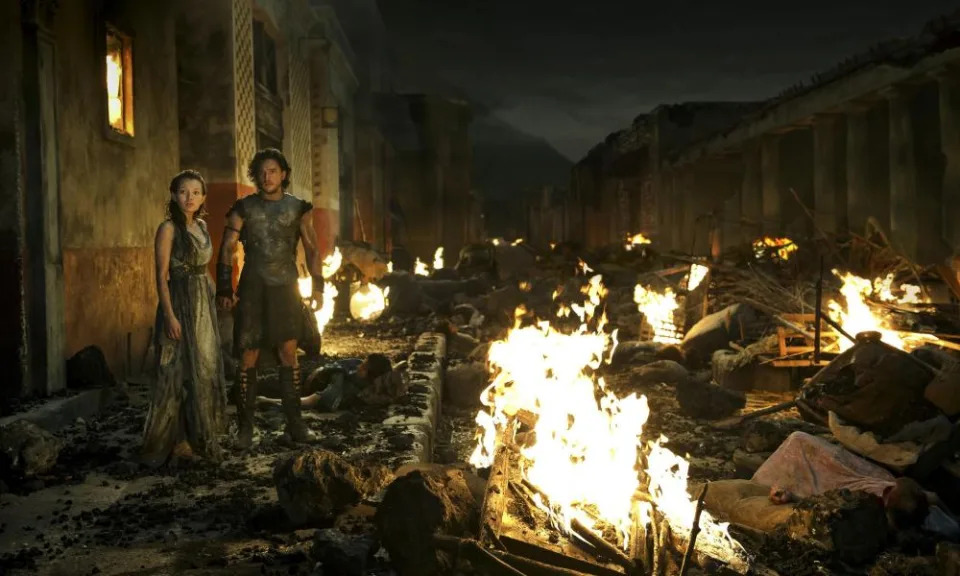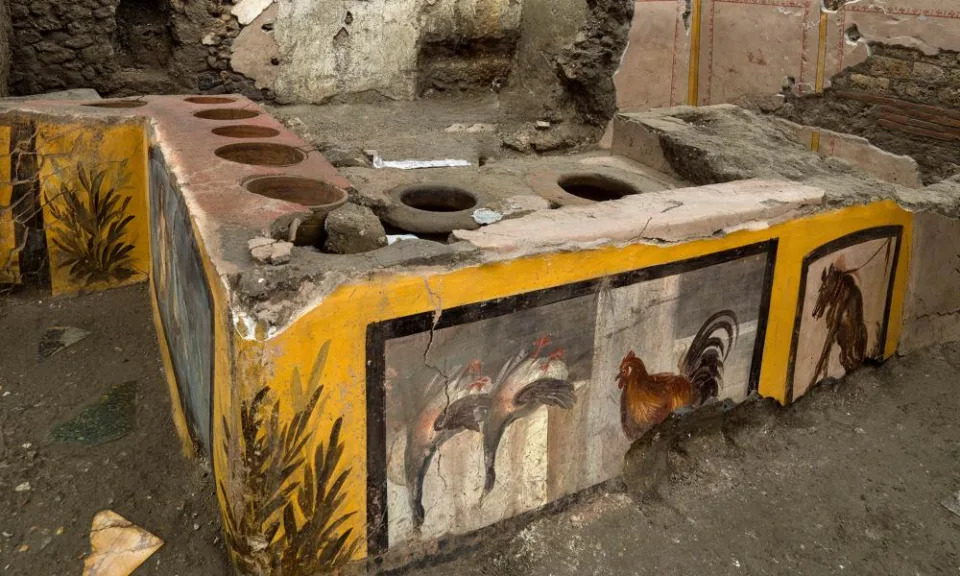Natalie Haynes
Sat, 4 March 2023

Photograph: Alamy
The first sign was smoke rising from the mountain and it was Pliny’s mother who noticed it. They didn’t know which mountain this cloud came from, Pliny the Younger says, but it rose in the air before spreading out like a pine tree. Pliny wrote two letters to his friend, the historian Tacitus. They are quietly devastating: my uncle died in a disaster that destroyed some of the most beautiful places there are.
Related: Discoveries in Pompeii reveal lives of lower and middle classes
The younger man lived to write about the eruption which would destroy whole towns in a day because he refused to join his uncle on a rescue boat heading towards Vesuvius. Pliny preferred to stay at home reading a history book. The story of Pompeii is full of such moments: lives preserved and destroyed, objects saved and lost, stories told or forgotten. And every new excavation produces more.
For as long as Pompeii has lain under volcanic debris – since 79 AD – people have been digging it up. Some of the earliest were treasure-hunters, some were disaster-tourists, and some were probably Pompeii’s former residents trying to get back their lost possessions.

A dig in region five of Pompeii in 2018 reveals a fresco of Leda and the swan. Photograph: Cesare Abbate/EPA
Although the popular image of Pompeii is of a town frozen in time, it has always been in a state of flux. With roughly a third of the town still unexcavated, there is understandable excitement at this week’s news that archaeologists have started to dig a new area of the site. Not least because recent finds in Region 5 (another newly excavated area) have been wonderful: the House of the Dolphins with its gorgeous entrance hall painted with birds as well as the dolphins that named it; brightly painted political graffiti on the façade of a house; and not omitting the fresco of Priapus, weighing his gigantic erection on a set of scales. Once seen, I doubt that’s ever forgotten.
Before 79, Pompeii was not a particularly well-known place. It’s rarely mentioned by historical sources of its time. A small town in Campania, it was too unfashionable for Rome’s elite to summer there: instead they went to Baiae, across the Bay of Naples. And when Pompeii came to Rome’s attention, it was rarely for a good reason. In 59AD, it held gladiatorial games in which the violence spilled onto the streets from the arena. People visiting Pompeii from nearby Nuceria were so badly beaten that survivors dragged their battered bodies to Rome to protest. Pompeii was banned from holding games for 10 years.
Ironically it was the obliteration of the town – along with others nearby – that put it on the map. And at least in part that’s because we have Pliny’s eye-witness account. But there is still a huge amount we don’t know. Even the date of the fateful eruption is contested. Pliny tells us that cloud rose into the sky on the ninth day before the Kalends of September (which would be 24 August, as we count it). But the archaeological evidence of plant matter from the area disputes this date, implying it was later in the autumn. This isn’t to suggest Pliny couldn’t tell what time of year it was, but his letter has been copied by scribes through the ages and mistakes do slide into manuscripts this way. All this is just part of the beguiling mystery of Pompeii. Even things which seem certain rarely are.

A thermopolium – a Roman fast food joint – found in 2020.
Photograph: Parco Archeologico Di Pompei/EPA
Plenty of people believe Pompeii was lost under a sea of molten lava, but it was pumice and ash that covered the city: that’s why if you want to see ancient buildings with more than one storey, you’re better off visiting Herculaneum. Herculaneum was hit by a pyroclastic surge of hot gas and ash – which killed its inhabitants very quickly – but its buildings received less damage than Pompeii, where most upper levels were demolished by huge flying lumps of rock.
When Pliny’s uncle paused in his attempted evacuation mission of those who lived near the volcano (he rushed to the place others fled from, Pliny tells Tacitus), he stopped to sleep. The friends he had come to rescue had to wake him so they could get him out of the room, as the courtyard outside filled with stones. If they’d waited any longer, says Pliny, they wouldn’t have been able to open the door. But it doesn’t matter in the end, as his uncle does not survive the eruption.Interactive
The number of those who died is also open to debate. About 1,100 bodies have been found in Pompeii so far, and roughly two-thirds of the site has been excavated. So perhaps 2,000 people may have died there. The rest of the population – estimates range between 7,000 and 30,000 – must have escaped when the earth tremors that preceded the eruption (as Pliny also reports) proved impossible to ignore.
There is so much to look forward to discovering over the next few years that I feel a bit of a killjoy reminding myself that the primary purpose of these new excavations is to keep the site safe from further harm, rather than to uncover incredible frescos of Greek myths, or revelations about first-century snack bars. Although recent finds have provided both of these at once, with the uncovering in 2020 of a thermopolium (a shop serving hot snacks). The counter of this fast-food joint was decorated with pictures of a rooster and ducks, which may have reflected the type of food served. But there was also a much grander fresco depicting a nereid (sea-nymph) riding a seahorse through fish-filled waters. Even if that counter served fish, it is a grandiose way of saying so.
Our relationship with remains from the ancient world has changed a great deal in the time that Pompeii has been drawing tourists. Once, archaeologists would “hide” recent discoveries near the surface of a site for visiting dignitaries to find. And while we would frown on this kind of behaviour now, it’s impossible to be too judgemental of those who were trying to keep resources flowing to their dig from whichever royal or other VIP came visiting.
While the new dig is about preservation rather than discovery, revelations and increased understanding of Pompeii will occur just the same. Archaeologists will be digging earth out of Region 9, preventing collapses that could easily damage the ruins that remain. Will they find another eye-catching fresco of Leda and Jupiter (in his disguise as a swan) as they dig? Or further proof of the little town’s contact with a much wider world? One of the most remarkable finds from Pompeii is an ivory statuette of the Indian goddess Yakshi.
Plenty of people believe Pompeii was lost under a sea of molten lava, but it was pumice and ash that covered the city: that’s why if you want to see ancient buildings with more than one storey, you’re better off visiting Herculaneum. Herculaneum was hit by a pyroclastic surge of hot gas and ash – which killed its inhabitants very quickly – but its buildings received less damage than Pompeii, where most upper levels were demolished by huge flying lumps of rock.
When Pliny’s uncle paused in his attempted evacuation mission of those who lived near the volcano (he rushed to the place others fled from, Pliny tells Tacitus), he stopped to sleep. The friends he had come to rescue had to wake him so they could get him out of the room, as the courtyard outside filled with stones. If they’d waited any longer, says Pliny, they wouldn’t have been able to open the door. But it doesn’t matter in the end, as his uncle does not survive the eruption.Interactive
The number of those who died is also open to debate. About 1,100 bodies have been found in Pompeii so far, and roughly two-thirds of the site has been excavated. So perhaps 2,000 people may have died there. The rest of the population – estimates range between 7,000 and 30,000 – must have escaped when the earth tremors that preceded the eruption (as Pliny also reports) proved impossible to ignore.
There is so much to look forward to discovering over the next few years that I feel a bit of a killjoy reminding myself that the primary purpose of these new excavations is to keep the site safe from further harm, rather than to uncover incredible frescos of Greek myths, or revelations about first-century snack bars. Although recent finds have provided both of these at once, with the uncovering in 2020 of a thermopolium (a shop serving hot snacks). The counter of this fast-food joint was decorated with pictures of a rooster and ducks, which may have reflected the type of food served. But there was also a much grander fresco depicting a nereid (sea-nymph) riding a seahorse through fish-filled waters. Even if that counter served fish, it is a grandiose way of saying so.
Our relationship with remains from the ancient world has changed a great deal in the time that Pompeii has been drawing tourists. Once, archaeologists would “hide” recent discoveries near the surface of a site for visiting dignitaries to find. And while we would frown on this kind of behaviour now, it’s impossible to be too judgemental of those who were trying to keep resources flowing to their dig from whichever royal or other VIP came visiting.
While the new dig is about preservation rather than discovery, revelations and increased understanding of Pompeii will occur just the same. Archaeologists will be digging earth out of Region 9, preventing collapses that could easily damage the ruins that remain. Will they find another eye-catching fresco of Leda and Jupiter (in his disguise as a swan) as they dig? Or further proof of the little town’s contact with a much wider world? One of the most remarkable finds from Pompeii is an ivory statuette of the Indian goddess Yakshi.
Interactive
The letter of Pliny the Younger that describes the eruption of Vesuvius reads like a disaster movie: the earth shuddering beneath carriage wheels so their vehicles suddenly jump across the road; a thick fog of smoke and debris so no one can see even a short distance; the island of Capri shrouded in ash, invisible to Pliny on the mainland. Some thought there were no gods anymore, he says, only endless night. And yet, Pliny survives, as does his mother and their friend. The story of this disaster will live for ever, he tells Tacitus: semper victurus. And as the archaeologists dig up a little more of Pompeii, and the world waits and watches, he is right.
The letter of Pliny the Younger that describes the eruption of Vesuvius reads like a disaster movie: the earth shuddering beneath carriage wheels so their vehicles suddenly jump across the road; a thick fog of smoke and debris so no one can see even a short distance; the island of Capri shrouded in ash, invisible to Pliny on the mainland. Some thought there were no gods anymore, he says, only endless night. And yet, Pliny survives, as does his mother and their friend. The story of this disaster will live for ever, he tells Tacitus: semper victurus. And as the archaeologists dig up a little more of Pompeii, and the world waits and watches, he is right.
No comments:
Post a Comment